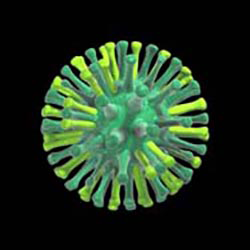
Popular topics

-
References
Baz M et al. (2015). Nonreplicating influenza A virus vaccines confer broad protection against lethal challenge. mBio, 6, e01487-4815.
Powell TJ et al. (2012). Pseudotyped Influenza A Virus as a vaccine for the Induction of Heterotypic Immunity. J Virol, 86, 13396-13406.
Schwartz JC et al. (2018). The major histocompatibility complex homozygous inbred Babraham pig as a resource for veterinary and translational medicine. HLA, https://doi.org/10.1111/tan.13281.
Tungatt K et al. (2018). Induction of influenza-specific local CD8 T-cells in the respiratory tract after aerosol delivery of vaccine antigen or virus in the Babraham inbred pig. PLoS Pathog, 14, e1007017.
Zens KD et al. (2016). Vaccine-generated lung tissue-resident memory T cells provide heterosubtypic protection to influenza infection. JCI Insight, 1, e85832.
Pigging up the Pace of Influenza A Vaccine Development

Influenza (flu) is generally thought of as a mild disease but it can cause severe complications and even be deadly. Pandemics of particularly virulent strains have been associated with high mortality rates and the 1918 Spanish flu (H1N1) pandemic caused around 50-100 million deaths worldwide.
More recent pandemics include bird flu (H5N1), 1997, and swine flu (H1N1pmd09), 2009; a new influenza pandemic, especially one that jumps from animals to humans, is always a possibility.
Developing an effective vaccine for flu is challenging as antigenic shift and drift means that the circulating strains are continuously evolving. Seasonal flu vaccines are usually developed by collecting data on different strains of influenza worldwide and then predicting which strains are most likely to spread and cause disease. Despite best efforts, the seasonal vaccine isn’t therefore always as effective as hoped.
Developing a ‘universal’ flu vaccine that delivers broad protection against a variety of different strains is highly desirable; rather than trying to catch up each season with a new vaccine. A one shot vaccine would also give much broader protection. In the context of flu pandemics, this would then provide researchers with valuable time to develop a strain specific vaccine to further reduce spread of disease and associated mortality rates.
Towards a Broad Influenza A Vaccine
There are four different strains of influenza virus, of which three can infect humans (influenza A-C). Influenza A and B cause seasonal epidemics, influenza C tends to cause much milder infections and influenza D only affects cattle.
Influenza A is associated with the majority of the disease burden, making it an attractive vaccine candidate. With this in mind, researchers from the University of Oxford have created an ‘S-FLU’ vaccine (a broadly protective influenza A virus vaccine) that has demonstrated a vigorous T cell response after delivery in both mice and ferrets and vaccinated animals challenged with H1 and H3 influenza viruses had a reduction in viral load (Powell et al. 2012, Baz et al. 2015).
Pigs as a Model Organism for Flu
Pigs are a natural host of the influenza virus and can be infected with human flu, bird flu and swine flu. They act as a good ‘mixing vessel’ to create new pandemic strains (like in 2009), so understanding their immune responses to flu is an important part of a vaccine development strategy. Additionally, they are physiologically more similar to humans than other models, such as mice and ferrets, with a more similar respiratory tract biology and volume. This makes them ideal for studying aerosol vaccine delivery mechanisms. However until now vaccine research has been limited by our inability to accurately measure the CD8+ T cell response to vaccine antigens in pigs.
Babraham Pigs Unlock CD8+ T cell Response
The Babraham pig is a line of inbred pigs which are physiologically closely related to humans and commercial pigs. They have a very high level of genetic similarity between animals and a recent paper showed that their MHC molecule equivalents (Swine Leukocyte Antigen (SLA)) are almost identical among individuals (Schwartz et al. 2018). This makes them really useful for studying the immune system and a valuable model for human preclinical disease.
The similarity of the Babraham pigs played an essential role in deducing a way to measure the exact number of killer T cells responding specifically to a vaccine antigen. For the first time, researchers were able to perform in vitro culture and cloning of pig T cells. They then used this technique to optimize staining protocols for soluble peptide-SLA-1. Using this method, they discovered that delivering the S-FLU vaccine by aerosol generated a strong killer T cell response in pigs (Tungatt et al. 2018).
Tracking T cells that elicit the protective immunity generated by the vaccine is an essential part of measuring vaccine efficacy. In particular, non-circulating tissue specific memory T cells have been shown to be a critical component of heterosubtypic immunity towards influenza (Zens et al. 2016). This groundbreaking discovery advances the Babraham pig as an immunological model and could significantly advance vaccine research. Importantly, the toolset developed by Tungatt et al., is not only confined to the study of flu and could in the future be applied to study other notable pig infections such as foot and mouth virus.
Studying the Pig Immune System?

Bio-Rad is a leader in translational animal model research and has a large selection of key pig markers available.
References
Baz M et al. (2015). Nonreplicating influenza A virus vaccines confer broad protection against lethal challenge. mBio, 6, e01487-4815.
Powell TJ et al. (2012). Pseudotyped Influenza A Virus as a vaccine for the Induction of Heterotypic Immunity. J Virol, 86, 13396-13406.
Schwartz JC et al. (2018). The major histocompatibility complex homozygous inbred Babraham pig as a resource for veterinary and translational medicine. HLA, https://doi.org/10.1111/tan.13281.
Tungatt K et al. (2018). Induction of influenza-specific local CD8 T-cells in the respiratory tract after aerosol delivery of vaccine antigen or virus in the Babraham inbred pig. PLoS Pathog, 14, e1007017.
Zens KD et al. (2016). Vaccine-generated lung tissue-resident memory T cells provide heterosubtypic protection to influenza infection. JCI Insight, 1, e85832.
You may also be interested in...

View more Veterinary or Article blogs















